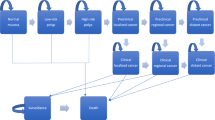Abstract
Background and aims
As shown previously, 40- to 50-year-old first-degree relatives of patients with colorectal cancer (CRC) have significantly more colorectal adenomas than controls of the same age. Screening colonoscopy of these persons at risk between 40 and 50 years might be cost beneficial.
Methods
We prepared a detailed cost–benefit analysis of screening colonoscopy and possible repeat endoscopies according to current expenditures for endoscopic procedures in Germany. Since screening colonoscopy is generally offered and reimbursed from 55 years on in Germany, we analysed the period between 45 and 55 years, taking an annual interest rate of 5% into account. Costs were analysed based on the results of a former study [11] depending on various participation rates in a general screening programme.
Findings
Based on the available 1994 figure of about €20,000 for diagnosis and treatment of one cancer case, screening colonoscopy is cost beneficial when participation is high. Under a more realistic assumption of currently about €40,000 per cancer case, screening colonoscopy is cost beneficial in any case.
Interpretation
Our data support that systematic screening colonoscopy in first-degree relatives of patients with CRC by the age of 45 years most likely demonstrates an economic benefit.



Similar content being viewed by others
References
Winawer SJ, Zauber AG, Ho MN (1993) Prevention of colorectal cancer by colonoscopic polypectomy. N Engl J Med 329:1977–1981
Eide TJ (1986) Risk of colorectal cancer in adenoma-bearing individuals within a defined population. Int J Cancer 38:173–176
O’Brien MJ, Winawer SJ, Zauber AG, Gottlieb LS, Sternberg SS, Diaz B, Dickersin GR, Ewing S, Geller S, Kasimian D (1990) The National Polyp Study. Patient and polyp characteristics associated with high-grade dysplasia in colorectal adenomas. Gastroenterology 98:371–379
Stryker SJ, Wolff BG, Culp CE, Libbe SD, Ilstrup DM, MacCarty RL (1987) Natural history of untreated colonic polyps. Gastroenterology 93:1009–1013
Nusko G, Mansmann U, Kirchner T, Hahn EG (2002) Risk related surveillance following colorectal polypectomy. Gut 51:424–428
Winawer SJ, Zauber AG, O’Brien MJ, Ho MN, Gottlieb L, Sternberg SS, Waye JD, Bond J, Schapiro M, Stewart ET (1993) Randomized comparison of surveillance intervals after colonoscopic removal of newly diagnosed adenomatous polyps. The National Polyp Study Workgroup. N Engl J Med 328:901–906
Hixson LJ, Fennerty MB, Sampliner RE (1994) Two year incidence of colon adenomas developing after tandem colonoscopy. Am J Gastroenterol 89:687–691
Avidan B, Sonnenberg A, Schnell TG, Leya J, Metz A, Sontag SJ (2002) New occurrence and recurrence of neoplasms within 5 years of a screening colonoscopy. Am J Gastroenterol 97:1524–1529
Schmiegel W, Adler G, Fruhmorgen P, Folsch U, Graeven U, Layer P, Petrasch S, Porschen R, Pox C, Sauerbruch T (2000) Colorectal carcinoma: prevention and early detection in an asymptomatic population—prevention in patients at risk—endoscopic diagnosis, therapy and after-care of polyps and carcinomas. German Society of Digestive and Metabolic Diseases/Study Group for Gastrointestinal Oncology. Z Gastroenterol 38:49–75
Gruppe HK (1999) Deutsche Empfehlungen zur gesundheitsökonomischen Evaluation—Revidierte Fassung des Hannoveraner Konsens. Gesundheitsökon Qualitätsmanag 4:A62–A64
Menges M, Fischinger J, Gärtner B, Thomas G, Wördehoff D, Maier M, Harloff M, Stegmaier C, Rädle J, Zeitz M (2005) Screening colonoscopy in 40–50 year old first-degree relatives of patients with colorectal cancer is efficient: a controlled multicenter study. Int J Colorectal Dis 2005 Sep 15:1–7 (Epub ahead of print)
Vijan S, Hwang EW, Hofer TP, Hayward RA (1999) Which colon cancer screening test? A comparison of costs, effectiveness, and compliance. Am J Med 111:662–664
Sonnenberg A, Delco F, Inadomi JM (2000) Cost-effectiveness of colonoscopy in screening for colorectal cancer. Ann Intern Med 133:573–584
Jorgensen OD, Kronborg O, Fenger C (1995) A randomized surveillance study of patients with pedunculated and small sessile tubular and tubulovillous adenomas. The Funen Adenoma Follow-up Study. Scand J Gastroenterol 30:686–692
Lieberman DA, Weiss DG, Bond JH, Ahnen DJ, Garewal H, Chejfec G (2000) Use of colonoscopy to screen asymptomatic adults for colorectal cancer. Veterans Affairs Cooperative Study Group 380. N Engl J Med 343:162–168
Kozuka S, Nogaki M (1975) Premalignancy of the mucosal polyp in the large intestine. II. Estimation of the periods required for malignant transformation of mucosal polyps. Dis Colon Rectum 18:494–500
Author information
Authors and Affiliations
Corresponding author
Rights and permissions
About this article
Cite this article
Menges, M., Gärtner, B., Georg, T. et al. Cost–benefit analysis of screening colonoscopy in 40- to 50-year-old first-degree relatives of patients with colorectal cancer. Int J Colorectal Dis 21, 596–601 (2006). https://doi.org/10.1007/s00384-005-0058-5
Accepted:
Published:
Issue Date:
DOI: https://doi.org/10.1007/s00384-005-0058-5




